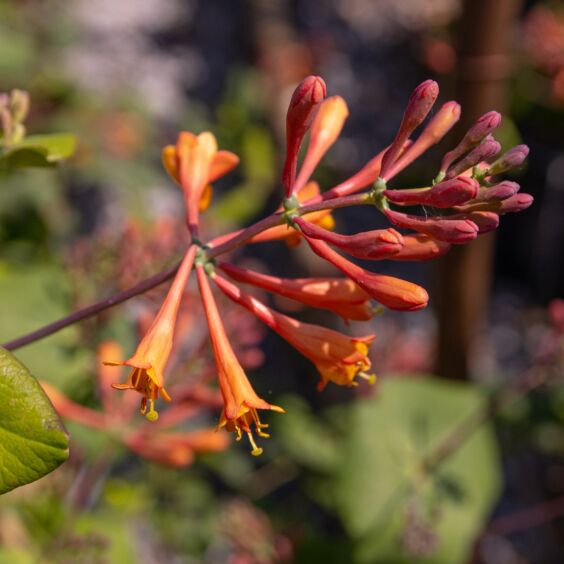
Growing zones
See Zone Map >Status: In stock
- Sun, Part Sun/Shade, Shade
Mature Plant Size (H x W): 6-10' x 4-6'
Bloom Season: Summer, Fall
- Attracts Bees
- Attracts Birds
- Salt Tolerant
- Long Blooming
- Walnut Toxicity Resistant
- Attracts Butterflies
Planting & Care for Dropmore Scarlet Honeysuckle Vines
Preparation
- They will grow in full sun or partial shade.
- Dropmore Scarlet Honeysuckle Vines are very adaptable.
- They will grow in any well-drained but moisture-retentive, humus-rich soil of reasonably fertility.
- They are vigorous twiners yet they have an informal habit of growth which makes them ideal for country and cottage gardens.
Opening Plant Material
- Container - Completely saturate all container plants by putting in a larger container of water until stops bubbling, then remove the plant from the container.
- Bare Root - Cut open the bundle (top and roots are tied) and separate all the plants. Soak roots in buckets of water until planted. Each plant type will be labeled separately for identification. Do not expose the roots to sun. They should never dry out. Keep roots covered. All bare-root plants must be trimmed when planted.
Planting Container
- Climbing Honeysuckle can be planted February-April
- Dig a hole no deeper than the depth of the container and 6" or more making sure it’s wider on the sides.
- Slide plant from pot by tapping on the bottom of the pot.
- With shovel or knife trim bottom 2" off of the root ball for plants in plastic containers.
- Rotate the plant to the proper position. Never lift or move plants by the tops.
- Place the root ball in the hole.
- Adjust the plant height so the root crown is slightly higher than the ground.
- Place fertilizer packets into the bottom of the hole (if purchased). *Use Our Recommended Fertilizer
- Back-fill the hole with soil, making sure the top of the root ball is visible and slightly higher than the soil around it.
- Firm the soil around the plant. Water well to settle soil around the root ball.
- Water frequently when newly planted.
Planting Bare Root
- Dig a hole at least 6" wider and the same depth as the root mass. The crown or graft of the plant should be slightly higher than ground level where it was grown at the nursery.
- Trim off the broken roots and branches.
- Place fertilizer packets in hole (if purchased). Do not place other fertilizers in the planting hole. *Use Our Recommended Fertilizer.
- Spread the roots and fill halfway with soil, then water until soil settles completely saturating the soil and planting pit.
- Re-adjust plant and fill the hole with the rest of the soil.
- Back fill the balance of the soil and water well.
Pruning - After Planting
- Container - Although it is not essential for container plants to be pruned after planting, a light pruning to remove any broken branches during shipment and improve shape will help the looks of your new planting.
- Bare Root - Prune ALL bare root plants to reduce transplant shock and ensure success. Pruning should occur either before or as soon after planting as possible. All pruning should be done with a sharp pruning shears.
Pruning - Through-out the Season
- Lonicera x brownii – you can either allow them to grow at will or reduce the flowered shoots by one-third in early spring to restrict the size of the plant.
- Shears may be used to trim the entire plant.
Watering – Through-out the Season
- Do not let honeysuckles suffer from prolonged lack of moisture.
- Water the plants thoroughly if the soil starts to dry out during long dry periods in the summer.
Planting & Handling Help
Download our Planting and Handling Guide below to plan for a successful arrival and install of your plants. Be sure to water all plants as soon as they arrive and every day until you’re ready to plant. Keep any bare root bundles in a shady, cool spot with the roots covered at all times.


Learn More
Watch our videos on handling bare root plants, how your order is prepared for shipment and more.


Plant Sizing
What is the difference between Containers, Grow Bags, Bare Root, and Balled & Burlap (B&B)?
Shipping Times


Our FedEx and local shipping times depend on two factors, one is by the region and the second is the type of product being shipped. For example, small fruits are only shipped in spring, but majority of our perennials are shipped from spring until fall. Keep in mind the dates below act as a general guide. Due to unpredictable weather, staffing, inventory and industry demands these timelines can change. Therefore, we cannot guarantee any of these times.
Shipping Dates by Region*
Northern Cold Region: April 22nd - November 7th
Northern Region: April 15th - November 7th
Middle Region: April 1st - November 7th
Southern Region: March 15th - November 7th
Local Delivery (small radius from Waterloo, WI): April 22nd - November 7th
Shipping Dates by Season*
Spring Shipping: Region Start Date (above) - May
Fall Shipping: September - November
Due to unpredictable weather, these times may vary. Some varieties are exceptions due to heat and plant health reasons. Enter your shipping zip code at the top of this page and be sure to check the shipping information on each product before you add it to your cart. If the product is too large or restricted in your state, you will not be able to checkout with that item in your cart.





